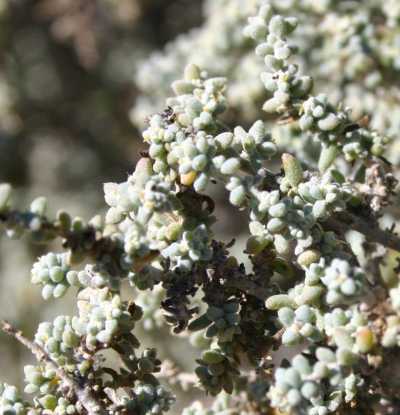Maireana pyramidata
black
bluebush
The black bluebush is one of the large group of Chenopods
found throughout Fowlers Gap and indeed Australia. The black bluebush
is quite common on Fowlers Gap, occuring on the alluvial plains of the
Station and along watercourses away from the the bulk of the carbonate-rich
soils of the Adelaide bedrocks.
Black bluebushes are densely-branched dull blue-grey shrubs
1-1.5 m high.
Bark: stems are sparsely to densely woolly.
Leaves: alternate, succulent, linear
to egg-shaped, 2-4 mm long and covered in short hairs.
Flowers: singular, occurring where the leaves join the stems.
Fruit: plentiful and bright to light green, a flat to top-shaped
tube and a wide horizontal wing , 10-15 mm wide with a raised centre.
Fruits become black when dry, hence the common name, and are easily crush.
Source: Frank Kutsche and Brendan Lay (2003). Field guide to
the plants of outback South Australia. Department of Water, Land and
Biodiversity Conservation, South Australia, ISBN 0 7590 1052 8.
Phillip Moore (2005). A guide to plants of inland Australia. Reed
New Holland, ISBN 1 876334 86 X.
Photos: Ian Roach
Back
|

 |







